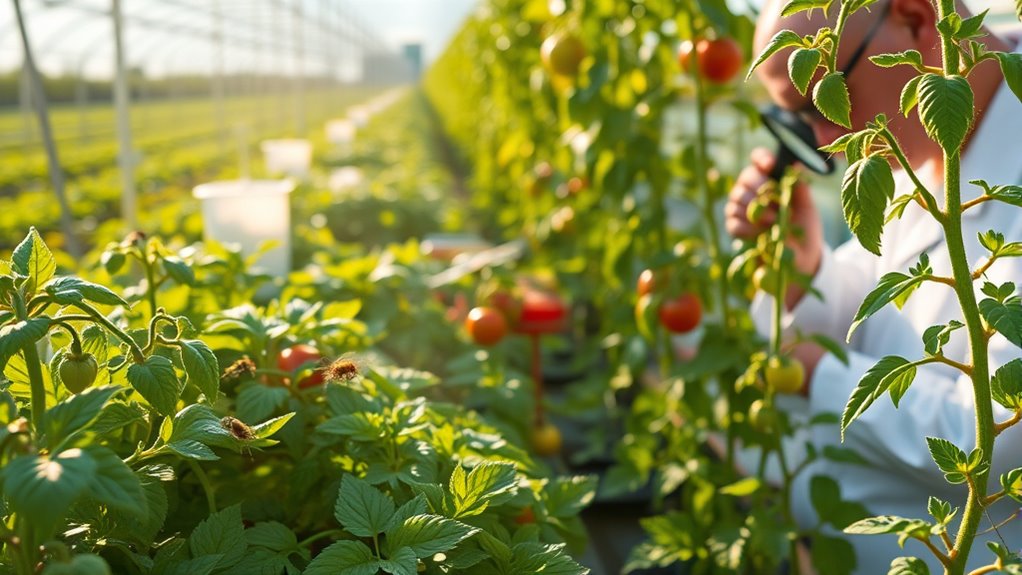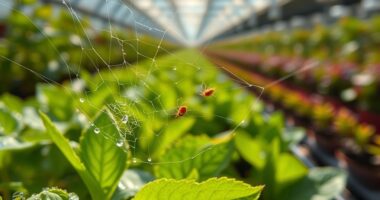To solve pest problems in greenhouses, you’ll find success using integrated approaches. Biological control with beneficial insects like predatory mites targets pests such as spider mites, whiteflies, and fungus gnat larvae. Combine this with cultural measures like crop rotation and soil sterilization to disrupt pest life cycles. Improving airflow and humidity controls further reduces favorable conditions for pests. Continuing to explore these strategies reveals how combining natural, environmental, and mechanical methods creates a healthy, pest-free greenhouse environment.
Key Takeaways
- Successful integration of biological agents like predatory mites and nematodes effectively reduced pest populations in greenhouse case studies.
- Implementing crop rotation and sanitation measures disrupted pest life cycles, leading to sustainable pest control outcomes.
- Enhancing environmental conditions such as airflow and humidity hindered pest breeding, as demonstrated in various greenhouse management cases.
- Combining mechanical removal, cultural practices, and biological control proved effective in reducing reliance on chemical pesticides.
- Visual storytelling and regular monitoring facilitated timely interventions, improving pest management success in greenhouse case studies.
Overcoming Aphid Infestations With Natural Predators
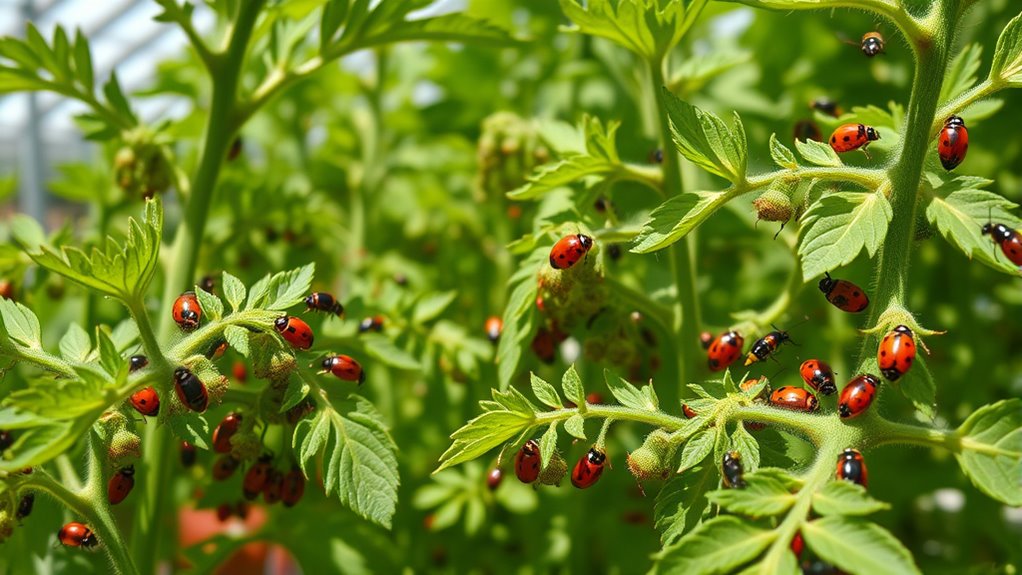
Have you ever struggled to control aphid outbreaks in your greenhouse? Using natural predators can be highly effective. Start by implementing companion planting; plants like marigolds or nasturtiums attract beneficial insects that prey on aphids. This creates a natural barrier, reducing pest numbers without chemicals.
Additionally, consider soil sterilization before planting, which eliminates aphid eggs and other pests hiding in the soil, preventing future outbreaks. Combining these methods fosters a healthier environment for your crops, encouraging beneficial insects to thrive and keep aphid populations in check.
Regular monitoring and early intervention are key. With patience and strategic planting, you can manage aphid infestations sustainably, reducing reliance on pesticides and promoting a balanced greenhouse ecosystem.
Managing Whitefly Outbreaks Using Integrated Pest Management
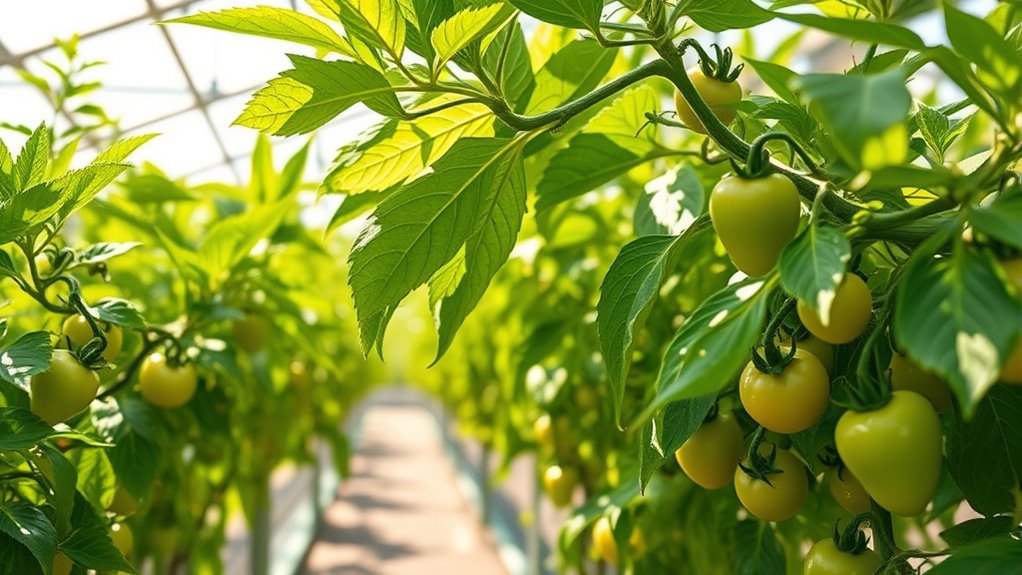
Managing whitefly outbreaks effectively involves combining biological control strategies with cultural and physical measures. Implementing pest management techniques can significantly reduce pest populations while promoting sustainable practices. This integrated approach helps you keep pests under control while minimizing chemical use. Using eye patches as part of a comprehensive routine can also support overall plant health by reducing stress and promoting recovery in affected plants. Additionally, leveraging automation in business can streamline monitoring processes, allowing for quicker responses to pest outbreaks. Incorporating diverse planter designs can improve airflow and reduce pest habitat, further aiding in pest management efforts. Understanding the importance of emotional support for staff managing pest issues can enhance team resilience and problem-solving.
Biological Control Strategies
Biological control strategies offer an effective way to manage whitefly outbreaks within integrated pest management (IPM) programs. By introducing natural enemies like predatory insects, you reduce reliance on chemicals and promote sustainable control.
Pest habitat modification helps make your greenhouse less attractive to whiteflies, such as by removing weeds or debris where they hide. Crop rotation strategies can also disrupt whitefly life cycles, preventing buildup of populations. Incorporating energy-efficient practices can further improve overall greenhouse sustainability and reduce operational costs.
Combining these tactics with biological agents enhances overall effectiveness. You should monitor pest levels regularly to time releases properly and ensure that natural predators establish successfully.
This integrated approach not only suppresses whitefly populations but also supports long-term pest management, keeping your greenhouse healthier and more productive.
Cultural and Physical Measures
Implementing cultural and physical measures plays a vital role in controlling whitefly outbreaks within an integrated pest management program. Soil sterilization helps eliminate whitefly eggs and larvae hiding in the soil, reducing future infestations. Dog names can also be used to create memorable associations with your garden practices, making pest management more engaging. Crop rotation disrupts whitefly life cycles by changing the host plants, preventing them from establishing a steady population. You should also remove weeds and plant debris that serve as whitefly habitats. Using physical barriers like screens or row covers can prevent whiteflies from reaching your crops. Regularly inspecting plants and promptly removing infested foliage helps keep populations in check. Incorporating nutritional strategies such as enhancing plant health can make crops more resistant to pest attacks. Together, soil sterilization, crop rotation, and physical barriers create a thorough approach that minimizes reliance on chemical controls and promotes a healthier greenhouse environment.
Battling Spider Mites Through Biological Control Methods
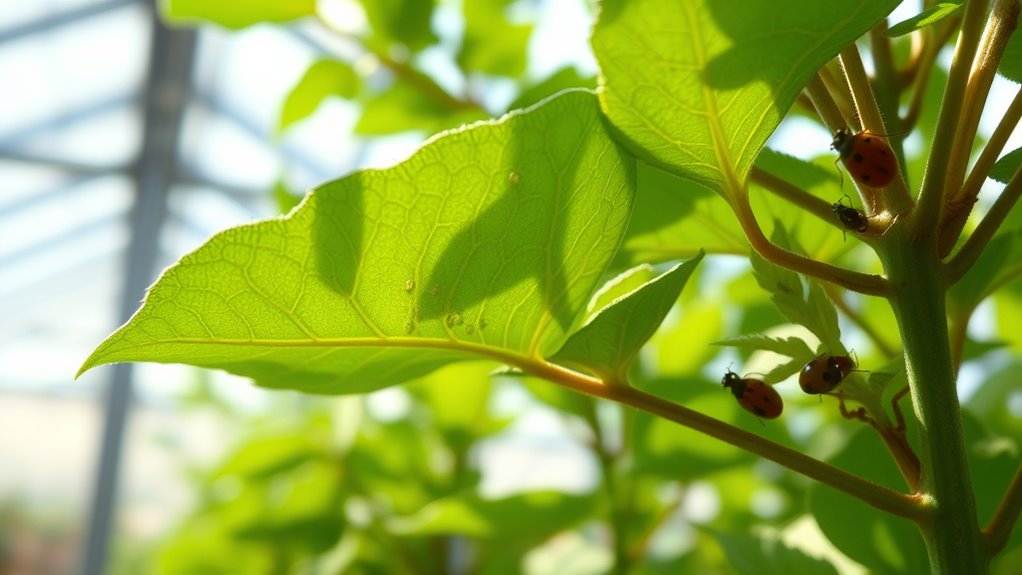
When spider mites threaten your greenhouse plants, introducing natural predators can be an effective control strategy. You can use beneficial insects like predatory mites, which feed on spider mites and help keep populations in check. Using integrated pest management techniques can further enhance the effectiveness of biological control. To enhance this biological control, consider companion planting with plants that repel mites or attract their predators. Light manipulation also plays a role; reducing intense light or increasing humidity can make conditions less favorable for spider mites, supporting your natural enemies. Additionally, maintaining proper environmental conditions such as proper ventilation can prevent pest infestations and promote plant health, making it more difficult for pests to establish themselves. Implementing environmental controls like humidity regulation can further discourage spider mite outbreaks. These methods work together to create an environment where biological control thrives, reducing the need for chemical pesticides.
Controlling Fungus Gnats With Cultural and Biological Strategies
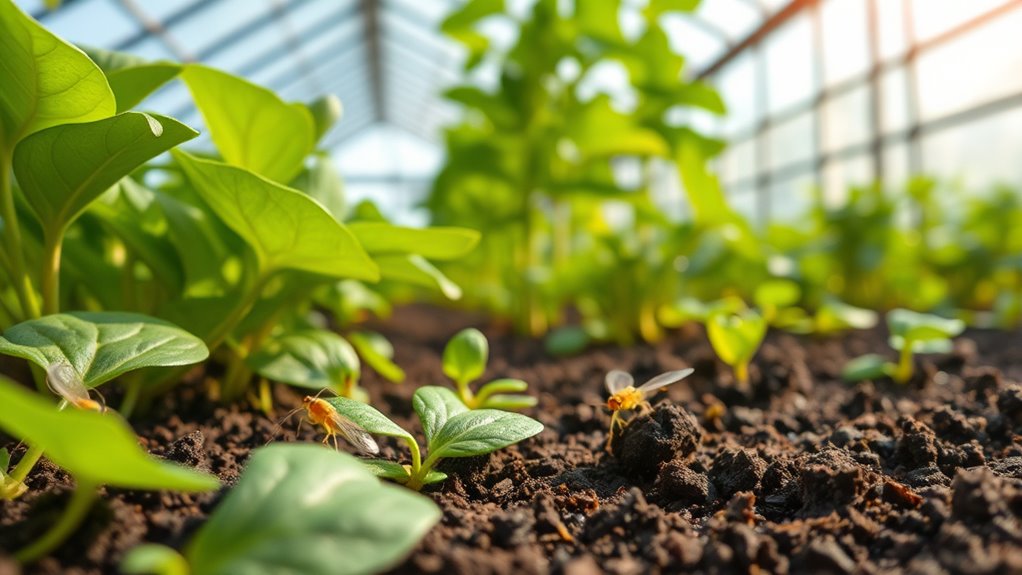
Maintaining ideal ventilation helps reduce humidity levels that attract fungus gnats. Incorporating beneficial biological agents, like predatory nematodes or fungi, can effectively target gnat larvae. Additionally, monitoring environmental conditions with advanced monitoring tools can help identify problem areas before infestations escalate. Properly managing humidity control is essential to prevent fungus gnat proliferation. Utilizing biological control agents can also provide a sustainable and chemical-free method to manage pest populations effectively. Regularly inspecting soil moisture levels ensures that conditions remain unfavorable for gnat development, further supporting integrated pest management strategies.
Optimal Ventilation Practices
Ideal ventilation is essential for controlling fungus gnat populations in greenhouse environments. Proper air circulation prevents stagnant air pockets, reducing humidity levels that favor gnat breeding.
By ensuring consistent airflow, you help maintain a drier environment that disrupts the fungus gnats’ life cycle. Humidity control is particularly important; high moisture promotes fungus growth, which serves as food for larval stages. Effective airflow management can significantly reduce breeding sites and improve overall plant health.
Using exhaust fans, vents, and oscillating fans improves air movement and helps regulate humidity effectively. Regularly monitoring humidity levels and adjusting ventilation accordingly creates an inhospitable environment for fungus gnats.
Good ventilation not only reduces breeding sites but also promotes healthier plant growth, making it a crucial cultural strategy in integrated pest management. Incorporating visual storytelling into your greenhouse management practices can also enhance understanding of environmental conditions and promote proactive pest control measures.
Beneficial Biological Agents
Introducing beneficial biological agents into your greenhouse can effectively suppress fungus gnat populations by targeting their larvae and adults naturally. These agents, such as predatory nematodes and specific fungi, work best when combined with cultural strategies like crop rotation and companion planting. By rotating crops, you disrupt gnat life cycles, reducing their breeding sites. Companion planting attracts beneficial insects and creates a less hospitable environment for gnats, enhancing biological control. Additionally, maintaining cultural hygiene helps prevent the buildup of pest populations and supports overall plant health. Implementing integrated pest management practices ensures a comprehensive approach to pest control. Here’s a quick overview:
| Biological Agent | Cultural Strategy | Target Species |
|---|---|---|
| Predatory Nematodes | Crop Rotation | Fungus Gnat Larvae |
| Bacillus thuringiensis | Companion Planting | Adult Fungus Gnats |
| Hypoaspis miles | Cultural Hygiene | Both Larvae and Adults |
Combining these methods creates a robust, sustainable pest management approach.
Addressing Caterpillar Damage With Targeted Mechanical Removal
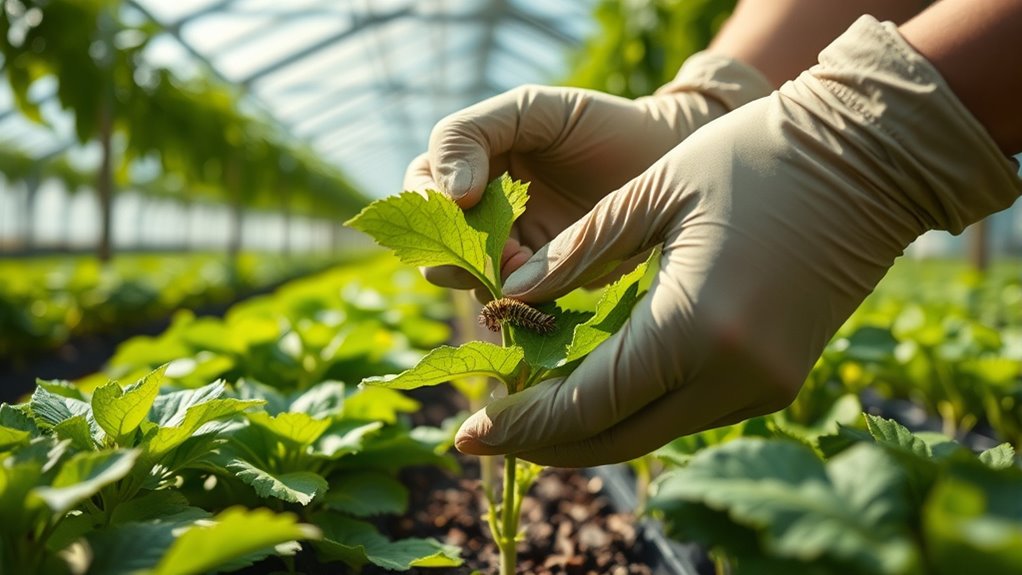
When caterpillar infestations threaten your crops, targeted mechanical removal offers an effective and environmentally friendly solution. This method involves manually removing caterpillars from plants, preventing them from causing further damage.
By inspecting your greenhouse regularly, you can spot caterpillars early and eliminate them before they multiply. Mechanical removal is especially useful for caterpillar control because it minimizes chemical use, reducing potential harm to beneficial insects and your plants.
Use gloves or tools like tweezers to carefully extract the pests, paying close attention to the undersides of leaves and hidden crevices. This precise approach helps keep your crops healthy and reduces pest populations naturally.
Consistent monitoring and removal are key to maintaining pest-free greenhouses and ensuring ideal crop growth.
Preventing Pest Recurrence via Environmental Adjustments

Adjusting your greenhouse environment plays a crucial role in preventing pest recurrence. Proper soil sterilization removes hidden pests and eggs, reducing future infestations.
Regulating humidity levels creates an environment less favorable for pests like fungus gnats and mites. By maintaining ideal humidity, you inhibit pest breeding cycles and keep plants healthier.
Consider these environmental adjustments:
- Perform soil sterilization regularly to eliminate pests lurking in soil.
- Regulate humidity precisely to deter pest proliferation.
- Improve ventilation to reduce stagnant air and moisture buildup.
Implementing these measures helps break pest life cycles and creates a less hospitable environment for future problems.
Consistent environmental management is key to sustaining a healthy, pest-free greenhouse.
Frequently Asked Questions
How Do I Identify Pest Infestations Early in Greenhouse Environments?
To identify pest infestations early in your greenhouse, monitor plants regularly for signs like damaged leaves or discoloration.
Learn the pest lifecycle to understand when they’re most vulnerable and active.
Use trap placement strategically around your greenhouse to catch pests early, making detection easier.
Regular inspections combined with proper trap placement help you catch problems before they spread, allowing for prompt and effective pest management.
What Are the Costs Associated With Biological Control Methods?
Imagine a lush greenhouse where pests threaten your crops, and biological control acts like a gentle guardian.
The cost analysis of biological control methods varies, often lower than chemical options, but requires an initial investment in beneficial insects or pathogens.
The economic impact can be positive, reducing long-term pesticide costs and promoting sustainable growth.
While upfront expenses exist, you gain a safer, eco-friendly solution that protects your harvest and your peace of mind.
How Can I Prevent Pests From Developing Resistance?
To prevent pest resistance, you should implement integrated management strategies that diversify control methods. Avoid relying solely on biological controls, as pests can develop resistance over time.
Rotate different pest control tactics, such as biological, chemical, and cultural methods, to keep pests off balance. Regular monitoring helps detect early signs of resistance, allowing you to adjust your approach promptly.
This approach ensures sustainable pest management and long-term crop health.
Are There Specific Pest Control Strategies for Different Greenhouse Crops?
You should use crop-specific pest management to effectively control pests in your greenhouse. Tailored control strategies consider the unique needs of each crop, reducing pesticide use and increasing success. For leafy greens, focus on biological controls, while for tomatoes, integrated pest management with monitoring works best. Adapting your approach to each crop helps target pests efficiently and minimizes resistance development, ensuring healthier plants and higher yields.
How Do Weather Conditions Influence Pest Management Effectiveness?
You might think weather doesn’t impact pest control, but climate adaptation proves otherwise. Weather conditions heavily influence pest migration patterns and the effectiveness of management strategies.
For instance, warm, humid weather encourages pest spread, making timely interventions essential. By understanding these patterns, you can adjust your pest management tactics accordingly.
Staying aware of climate fluctuations helps you optimize control methods, ensuring your greenhouse remains pest-free despite changing weather conditions.
Conclusion
By exploring these case studies, you see that natural predators and integrated strategies effectively control greenhouse pests. While some believe pests will always return, research suggests environmental adjustments and biological controls can break this cycle. If you stay proactive and adapt your methods, you can keep pests at bay without relying solely on chemicals. Embrace these proven techniques, and you’ll likely find that a healthy, pest-free greenhouse is within your reach.
